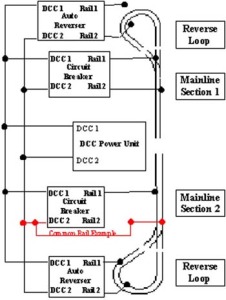Reverser and Breakers for DCC
by Stefano Curtarolo, last update - January 2005
| DCC Auto Reverser and Circuit Breaker Comparison Table | |||||||
| Features |
Digitrax PM4
|
Lenz LK100
|
MRC AD520
|
Tony's PSOnereplaced by PSX
|
Tony's PSTwo replaced by PSX
|
Tony's PSFour replaced by PSX
|
Tony's PSReverse replaced by PSX
|
| Unit Costs (List Price) (1) |
$23, $80
|
$57
|
$34.95
|
$29.95
|
$24.98, $49.95
|
$19.98, $79.95
|
$39.95
|
| Amps (2) |
12
|
5
|
2
|
8
|
8
|
8
|
8
|
| Response Timing |
slow
|
slow
|
slow
|
fast
|
fast
|
fast
|
fast
|
| Manual Reset (Option) |
no
|
no
|
no
|
yes
|
yes
|
yes
|
yes
|
| Status Lites |
some
|
no
|
no
|
yes/all
|
yes/all
|
yes/all
|
yes/all
|
| Programming Required |
yes
|
no
|
no
|
optional w/jumpers
|
optional w/jumpers
|
optional w/jumpers
|
optional w/jumpers
|
| Reverser with Breaker (3) |
yes
|
no
|
no
|
no
|
no
|
no
|
yes
|
| Mechanical Relays |
yes
|
yes
|
yes
|
no
|
no
|
no
|
no
|
| Solid State Relays |
no
|
no
|
no
|
yes
|
yes
|
yes
|
yes
|
| Power Supply Needed |
yes
|
no
|
no
|
no
|
no
|
no
|
no
|
| (1) The PM4 has 4 outputs so the cost: $80.00, plus power supply: $12.00 $92.00 is divided by 4 for this analysis." (2) Specified as trip current for Digitrax PM4. (3) PM4 requires at least 1 of 4 outputs to provide short circuit protection when using Auto Reverse for other outputs. |
|||||||
During designing and building a freight yard and loco depot (with roundhouse and turntable), I looked at the auto reversers and circuit breakers for DCC. Circuit Breakers and Auto Reversers provide short isolation and track reversal (as needed by loops, wyes and turntables) for your entire layout, as shown in the following drawing. For simplicity, the layout shown has only two mainline track sections, Section 1 and Section 2. Many layouts have more than two mainline (non-reversing) track sections, each of which would be protected with a breaker. These breakers prevent shutdown of the other parts of the layout when a short occurs within one section. Note that between adjacent mainline sections, as the train passes from one section to the next. The layout shown also has only two reversing sections. A large layout might have more, and reversers can be added as needed. Note that some reversers provide the breaker function (to isolate faults) within its track section, as well as track reversal. So on this example layout, a fault on any section of the layout would be isolated from all other sections. Track reversal is provided as traffic moves around the two reverse loops. All this is provided from a simple DCC power unit (needs no built-in reverse function).
I tested all the modern versions and have documented my findings below. All the accessories I tested use short circuit sensing to switch polarity. The switching is done with mechanical relays or with solid state transistors. When designing loops, the modeler should understand that long trains may short the gaps at each end of the reverse section at the same time. This can be avoided by running trains shorter than the loop, or designing the loop longer than your longest train.
PRODUCTS:
MRC AD520, Auto Reverser.
This is a very small and simple device: two input and two output wires (need to solder). Unfortunately no short circuit protection is provided for. The price is $34.95. The switching is done with mechanical relays. No extra power supply is needed.
LENZ LK100, Auto Reverser.
This simple device has two input and two output connectors (no need to solder). The short circuit current can be regulated with a trimmer. The price is $57. Like the MRC AD520, no short circuit protection is needed. No extra power supply provided.
DIGITRAX PM4, Auto Reverser/Breaker.
This device has 4 outputs, dual capabilities and the cost is $79.95. The modeler has to add a local power supply (13$). The PM4 has a large connector with 4 independent inputs and outputs (need to solder). The switching is done with relays. The short current is programmable with internal CVs. It is possible to use the PM4 outside a Digitrax environment, but I really think that the modeler NEEDS to be a Digitrax user to program and use all the capabilities of this device. Some LEDS tell the status of the device.
TONY'S POWER SHIELD(TM),CIRCUIT BREAKERS(PSOne, PSTwo, PSFour) AND POWER SHIELD/AUTO REVERSER (PSReverse) with short circuit protection.
These devices are very simple to use, and they are the only breaker/reverser with solid state mosfet switches. Their prices are $29.95 (each for four) for the reverser/breaker and $21.00 (each for four) for the breaker. QTY pricing is available(2,4,etc.) Plated through holes are provided for input/output connections. No extra power supply needed. PSOne, PSTwo, PSFour & PSReverse are separate modules that use the same circuit board and different components. Gray shaded components represent PSOne, PSTwo, PSFour assembly. Gray & red represent PSReverse assembly.
PSEUDO AND REAL COST:
Due to the diversity of each component, it is hard to compare the costs, without knowing the final use. Here are the different combinations that I evaluated.
1) The modeler needs to protect 4 or more sections, so he/she can choose between PM4 and PSOne, PSTwo, PSFour. The cost is $24 per section for PM4 (with power supply), and $21 for the PS. The choice depends on the use of the other PM4 outputs.
2) The modeler needs to reverse 4 sections, so he/she can choose among the PM4, the PSReverse, the AD520 and the LK100. The cost is $24 per section for PM4 (without short circuit protection), $35 for AD520 (without protection), $59 for the LK100 (without short circuit protection), and $39.95 for PSReverse (with short circuit protection). The choice between PM4 and PSReverse depends on if you want the Rev. sections to have short circuit protection. The PM4 requires one output to provide short circuit protection.
3) The modeler needs to reverse and to protect sections, so he/she can choose between the PM4 and the PSReverse. Since the 4 PM4 outputs cannot be breaker and reverser simultaneously, the modeler can program one output to be the breaker for the other 3 reversers (some wiring and throttle programming are necessary). In this way, the breaker/reverser output would cost $30.00, but a short in one section would stop the other sections. A better and more elegant solution might be to use 2 of the 4 outputs to protect the other 2 output-reversers in the same board (wiring and programming necessary). The cost would be $46 for each breaker/reverser configuration. The price for the PSReverse is $39.95, since this device has both capabilities. The choice depends on cost, simplicity, wiring, programming, or spark protection.
SPARKS:
Wheels are important, so the reverser design should minimize sparks. When the wheels cross the gap, a short circuit is produced and the devices understand that it is time to reverse polarity. The short causes sparks which burns the wheels profile (little dark spots indicate local melt of the metal). Gap after gap, month after month, the wheel become all dark and the electrical pickup reduced. I am a modeler, so I do not want my small N scale brass steamers to be damaged by those gap-sparks !!!!! In simple terms, the energy of the sparks (equal to the melting of a little spot in the wheel) is proportional to the intensity of the short multiplied by the time of the short. On the PM4 and LK100, the modeler can decrease the short current to decrease the intensity of the sparks, up to a limit, after which the device starts to flip continuously. Unfortunately, relay based devices are slow to switch so sparks can never be totally eliminated. The AD520, LK100 and PM4 are relays based, and only LK100 and PM4 have adjustable short circuit current. The photos show the minimum size of sparks I was able to reproduce keeping the system above the auto-flipping threshold. PSReverse is solid state based device so the switching time is so fast that the biggest possible short current (5A, not adjustable) would never produce visible sparks. If you really care about your loco wheels you should consider this phenomenum.
SHORT INSIDE THE SECTION:
The short current has to be adjusted in the way that the biggest load inside the section should not cause the reverser to flip continuously (with LK100 and PM4). Making a short with a screwdriver, it is possible to see:
1) MRC-AD520, big spark, some auto flipping until the booster breaks
2) LENZ-LK100, moderate spark, some auto flipping until the booster breaks
3) DIG-PM4, moderate spark, then the breaker, if used, stops, or produces very quick auto-flipping until the booster short circuits. The modeler should consider the different (programmable) switching time of the PM4 compared to the booster
4) PSReverse (or PSOne, PSTwo, PSFour), almost invisible spark, a short bzzzz, and the short circuit protection activates. The booster never short circuits.
CROSSING THE GAPS:
If one loco or a consist is crossing the gap, all 4 devices do their work. They simply reverse the polarity generating sparks as desribed above. Try during the night without any light. PSReverse makes no noise and almost no sparks (really small). The problems arise when the modeler wants to stop suddenly and start the loco/consist inside the reverse section. For low short circuit current settings, reversers sense the peak of the sudden start/stop load as a short and reverse the polarity. If a leadfoot modeler stops the loco/consist just above the gap, and accelerates instantaneously, the reverser flips continuously causing a long short until the breaker or the booster acts. This situation is not good and can cause burning of loco electrical pickup and wheels. To avoid this, the modeler should increase the short current, but this would increase the spark intensity and so decrease the life of the wheels... Unluckily there is no way to get an elegant solution with relays based devices. The PSReverse, solid state based, has the highest short current (5A) and the shortest switching time. In this way the problem is minimized.
SOUNDTRAXX CONSIDERATIONS:
Shorts and sparks are bad for Soundtraxx decoders. After repeated cycles of relays based switchings, my test Soundtraxx steam loco (Bachmann Consolidation), lost ..... her memory and reset to her default CVs. This is a known effect of repetitive shorts with Soundtraxx DSD's and DSX's. This did not occur with the solid state based device (PSReverse). There is also another problem that DCC users may encounter using Soundtraxx DSD with DCC Boosters Auto Reverser and Circuit Breakers. On power up or short circuit recycling the DSD has a high initial current draw. Several (3 or more) DSD's in a reverse or power block will create enough of a load to prevent power up.
NOTHING IS PERFECT:
Digitrax PM4 is a good product if integrated in a Digitrax environment: Loconet, feedback, status...good for model trains gurus !! PSOne, PSTwo, PSFour and PSReverse are simpler, can be used with all DCC systems and can solve more problems for modelers.
Good luck !
Stefano Curtarolo




